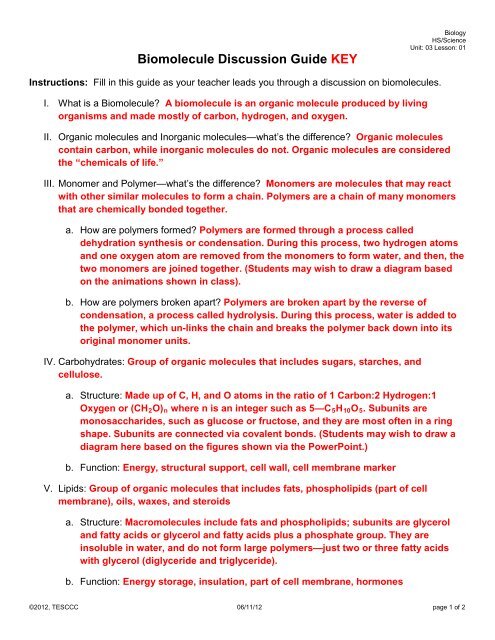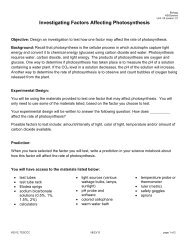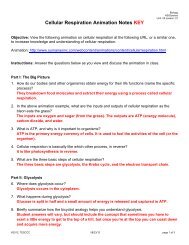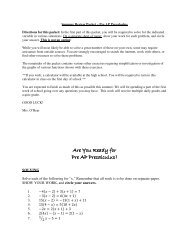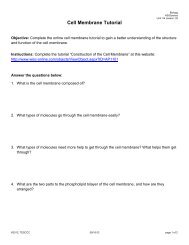Biomolecule Discussion Guide KEY
Biomolecule Discussion Guide KEY
Biomolecule Discussion Guide KEY
Create successful ePaper yourself
Turn your PDF publications into a flip-book with our unique Google optimized e-Paper software.
<strong>Biomolecule</strong> <strong>Discussion</strong> <strong>Guide</strong> <strong>KEY</strong><br />
Biology<br />
HS/Science<br />
Unit: 03 Lesson: 01<br />
Instructions: Fill in this guide as your teacher leads you through a discussion on biomolecules.<br />
I. What is a <strong>Biomolecule</strong>? A biomolecule is an organic molecule produced by living<br />
organisms and made mostly of carbon, hydrogen, and oxygen.<br />
II. Organic molecules and Inorganic molecules—what’s the difference? Organic molecules<br />
contain carbon, while inorganic molecules do not. Organic molecules are considered<br />
the “chemicals of life.”<br />
III. Monomer and Polymer—what’s the difference? Monomers are molecules that may react<br />
with other similar molecules to form a chain. Polymers are a chain of many monomers<br />
that are chemically bonded together.<br />
a. How are polymers formed? Polymers are formed through a process called<br />
dehydration synthesis or condensation. During this process, two hydrogen atoms<br />
and one oxygen atom are removed from the monomers to form water, and then, the<br />
two monomers are joined together. (Students may wish to draw a diagram based<br />
on the animations shown in class).<br />
b. How are polymers broken apart? Polymers are broken apart by the reverse of<br />
condensation, a process called hydrolysis. During this process, water is added to<br />
the polymer, which un-links the chain and breaks the polymer back down into its<br />
original monomer units.<br />
IV. Carbohydrates: Group of organic molecules that includes sugars, starches, and<br />
cellulose.<br />
a. Structure: Made up of C, H, and O atoms in the ratio of 1 Carbon:2 Hydrogen:1<br />
Oxygen or (CH 2 O) n where n is an integer such as 5—C 5 H 10 O 5 . Subunits are<br />
monosaccharides, such as glucose or fructose, and they are most often in a ring<br />
shape. Subunits are connected via covalent bonds. (Students may wish to draw a<br />
diagram here based on the figures shown via the PowerPoint.)<br />
b. Function: Energy, structural support, cell wall, cell membrane marker<br />
V. Lipids: Group of organic molecules that includes fats, phospholipids (part of cell<br />
membrane), oils, waxes, and steroids<br />
a. Structure: Macromolecules include fats and phospholipids; subunits are glycerol<br />
and fatty acids or glycerol and fatty acids plus a phosphate group. They are<br />
insoluble in water, and do not form large polymers—just two or three fatty acids<br />
with glycerol (diglyceride and triglyceride).<br />
b. Function: Energy storage, insulation, part of cell membrane, hormones<br />
©2012, TESCCC 06/11/12 page 1 of 2
VI. Proteins: Group of organic molecules that provide structure and facilitate chemical<br />
reactions.<br />
Biology<br />
HS/Science<br />
Unit: 03 Lesson: 01<br />
a. Structure: Very large molecules; globular or structural protein; subunits are amino<br />
acids, which are connected by peptide bonds (covalent bond)<br />
b. Function: Numerous functions including enzymes (speed rate of chemical<br />
reactions); structural components in cells, mechanical functions in muscles and<br />
cytoskeleton, cell signaling and immune response<br />
VII. Nucleic Acids: Group of organic molecules including DNA and RNA.<br />
a. Structure: Subunits are nucleotides made of a 5-carbon sugar, a nitrogen base, and<br />
one or more phosphate groups. (Students may wish to draw a picture based on<br />
figures shown in the PowerPoint.)<br />
b. Function: Encode genes and gene expression (storage and retrieval of information)<br />
©2012, TESCCC 06/11/12 page 2 of 2


